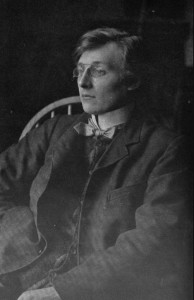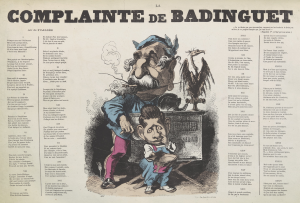Thanks to the sterling efforts of colleagues in Collections and Academic Liaison (CAL), a hitherto underutilised section of the Royal Commonwealth Society (RCS) library has recently been catalogued. 2252 titles running to almost 79 metres of shelving under the ‘Foreign colonies’ classification have now been added to iDiscover. Previously these titles were only discoverable through a labyrinthine card catalogue situated in the Rare Books Reading Room at Cambridge University Library; potential users had to know of the existence of this collection and had to physically visit the UL to access the card catalogue.
Continue reading “Cataloguing of the Royal Commonwealth Society Library’s ‘Foreign colonies’ section”Category: Special collections
Bowness and a touch of synchronicity
Sir Alan Bowness, director of the Tate Gallery in the 1980s and son-in-law of Barbara Hepworth and Ben Nicholson, donated to the UL his extensive art history library, containing many exhibition catalogues and private view cards. In recent years several blog posts have been devoted to progress on the Bowness collection, the earliest in 2019. This year I have been working on adding more exhibition catalogues to the library catalogue. I have been struck by how relevant the collection is now as over and over again I have noticed links between it and the 2024 cultural world. Continue reading “Bowness and a touch of synchronicity”
Who was Gordon Craig?

Have you ever noticed the Gordon Craig Theatre when travelling through Stevenage station and wondered who Gordon Craig was? I did and after a quick search on my phone it was soon apparent that this was a figure with an interesting and complex life worth writing about. Born in Stevenage (hence the theatre being named after him), Gordon Craig (1872-1966) was the son of the famous actress Ellen Terry, and as a young man he too was an actor alongside his mother in Henry Irving’s company. Much of his later work related to the theatre – stage designs, directing and writing widely on the theatre – but he also produced woodcuts and bookplates. This blog post will explore some aspects of his life and work using the UL’s rich collections. Continue reading “Who was Gordon Craig?”
Illustrated books and humour in Cambridge University Library’s Liberation collection (1944-1946)
This year will mark the 80th anniversary of the Normandy landings and the Liberation of France from German occupation, at the end of the Second World War. As part of the ongoing promotion of and research into Cambridge University’s Library Liberation collection (1944-1946), we have been delighted to shed light on Sophie Dubillot’s AHRC-funded collaborative (Cambridge UL and Open University) PhD project: ‘Ce n’est pas une blague: Purposes and Limits of Visual Humour in Early Post-War France (1944-46)’ and on the Liberation Collection (1944-46) Visiting Scholarship at Cambridge UL, whose first recipient will be announced in the next few weeks. We would be very happy to welcome you on Tuesday 19th March, 5-6pm at the Faculty of Divinity on the Sidgwick site, for Sophie Dubillot and Irène Fabry-Tehranchi’s talk on the Liberation collection: Illustrated books and humour in Cambridge University Library’s Liberation collection (1944-46), as part of the Cambridge Festival (you can register here).
This talk will examine a selection of the Liberation collection’s illustrated works (ranging from deluxe fundraising anthologies to commemorative works, clandestine printing and poetry), as well as humorous drawings representing struggles (such as restrictions, housing issues, and missing family members), in an ideologically divided country in dire need of reconstruction.
Irène Fabry-Tehranchi
Percy Cruikshank’s Panorama of the Franco-Prussian war (1870) in context
Two years ago, Cambridge University Library acquired a satirical pocket-size (but 3 meters long, once unfolded) Panorama of the Franco-Prussian war by Percy Cruikshank (1870) (8000.e.354). This work is a good complement to the library’s Collection of 1870-71 Franco-Prussian caricatures from a British perspective. In a talk taking place on Thursday 7 March from 5-6pm in the University Library’s Milstein room, as part of the Cambridge History of Material Texts seminar, we are going to present Cruikshank’s panorama and contextualise this work within the author’s creation of other comic cartoons produced in the concertina format.
Continue reading “Percy Cruikshank’s Panorama of the Franco-Prussian war (1870) in context”
La Complainte de Badinguet by André Gill (1870): translation and exhibition
A new exhibition of a selection of facsimiles of Cambridge University Library’s collection of 1870-71 caricatures is opening on 12 February at the Seeley Library (History faculty). This accompanies an ongoing translation project. This year, Geordie Cheetham worked on the translation and commentary of the song “La Complainte de Badinguet” (Badinguet’s Lament, CUL, KF.3.9, p. 162), published in Paris c. 1870 and attributed to the caricaturist, painter and song-writer André Gill (1840-1885).
This satirical piece imagines the (by that point former) French Emperor Napoleon III writing a lament following his defeat and capture in the Franco-Prussian war (1870-71). He was nicknamed ‘Badinguet’ after the name of a worker who helped him escape from prison following an attempted coup in 1846. The image shows the demoted emperor playing a barrel organ inscribed “Sedan” and his son Louis-Napoléon Bonaparte picking his nose and making a collection, accompanied by a skeletal eagle. Continue reading “La Complainte de Badinguet by André Gill (1870): translation and exhibition”
A deluxe edition of ‘Twenty love poems and A song of despair’ for Cambridge
The University Library has recently received a special limited edition of Pablo Neruda’s Veinte poemas de amor y una canción desesperada. Presented to the University in 1991 by Patricio Aylwin Azócar, former President of Chile, this copy is no. 555 of 250 copies printed from 501 to 750 and features a dedication to the University of Cambridge by the Chilean president.
Pablo Neruda (Chile, 1904-1973) won the Nobel Prize for Literature in 1971. He is best known for his poetry, most notably this work, which he wrote in 1924 when he was just nineteen years old. Neruda’s works are widely represented in the Cambridge Libraries collections, both in Spanish and in English translation (click here to view our holdings in iDiscover).
This particular edition of Twenty love poems and ‘A song of despair’ was printed by Ismael Espinosa in 1990 in Santiago de Chile.[i] It is presented in elephant folio, with a satin ribbon, illustrated with eight original glazes by Chilean magical realism painter Hernán Valdovinos. The volume is beautifully bound in peacock-feather decorated cloth, with gold paper-title-label insert on the front panel and marbled endpapers.[ii] The calligraphy is by María Angélica Seguel.



Sonia Morcillo
[i] Ismael Espinosa talks about this edition in Revelaciones de un editor de Neruda, El Mercurio, Sept. 25, 1988, p. E16 (available online at: https://www.bibliotecanacionaldigital.gob.cl/bnd/628/w3-article-297688.html)
[ii] Description details source: The Edmonton Book Store, Canada.
“Chameleonic games” in the 1870-71 caricatures collections
If over the recent holidays you have been roped into playing party games, which ones would you have encountered in 1870-71? Among the latest paper cut-out games and board games, fully engaging with contemporary historical and political events, Parisians of the time could have tackled the two “Jeux caméléoniens”, or Chameleonic Games by Louis-Valentin-Émile de La Tremblais, a painter and draughtsman probably of aristocratic origin.

The wonderful woodcuts (and more) of Frans Masereel

Woodcuts are an attractive art form to me and have featured in our blog before – see Twentieth century German woodcuts – so I was delighted to come across a book featuring woodcuts by Frans Masereel (1889-1972) while writing the recent post on Till Eulenspiegel, and to discover that the UL has a good selection of other works by him which will be explored in this post. Masereel’s name is not a familiar one now but in the 1920s he was very prolific and well-known, employing a distinctive Expressionist style in illustrations for books by other authors as well as in his own novels without words which were influential forerunners of the graphic novels of today. Continue reading “The wonderful woodcuts (and more) of Frans Masereel”
Glorious Christmas greenery

One of the Christmas carols sung this year by the Library choir was a version of The holly and the ivy. This inspired me to choose greenery associated with Christmas for this year’s festive blog post. Christmas trees (a little more on these later) have had brief mentions in previous years (2020’s A very merry online Christmas and 2014’s Christmas comes but once a year) but other traditional Christmas plants such as holly, ivy and mistletoe are new territory here and provide the opportunity to showcase some wonderful botanical art from across the centuries contained in UL books.
In pre-Christian pagan times evergreen plants were used to help celebrate the winter solstice festival, warding off evil spirits. Later on, the plants were given meaning by the Christian church. The fact that many of us today still continue the ancient tradition of decorating our spaces with greenery is rather pleasing. In my house, we will have a holly wreath on the door, ivy adorning the staircase and the tops of pictures, and mistletoe strategically placed for a kiss or two! Continue reading “Glorious Christmas greenery”




![20220705_150334a Panorama of the Franco Prussian War, painted by PC [Percy Cruikshank], London : F. Platts, 185 Fleet Street EC, & Mann Nephews, 39 Cornhill E.C., [1870-71].](https://europeancollections.files.wordpress.com/2022/08/20220705_150334a.jpg?w=341&resize=341%2C284#038;h=284)


